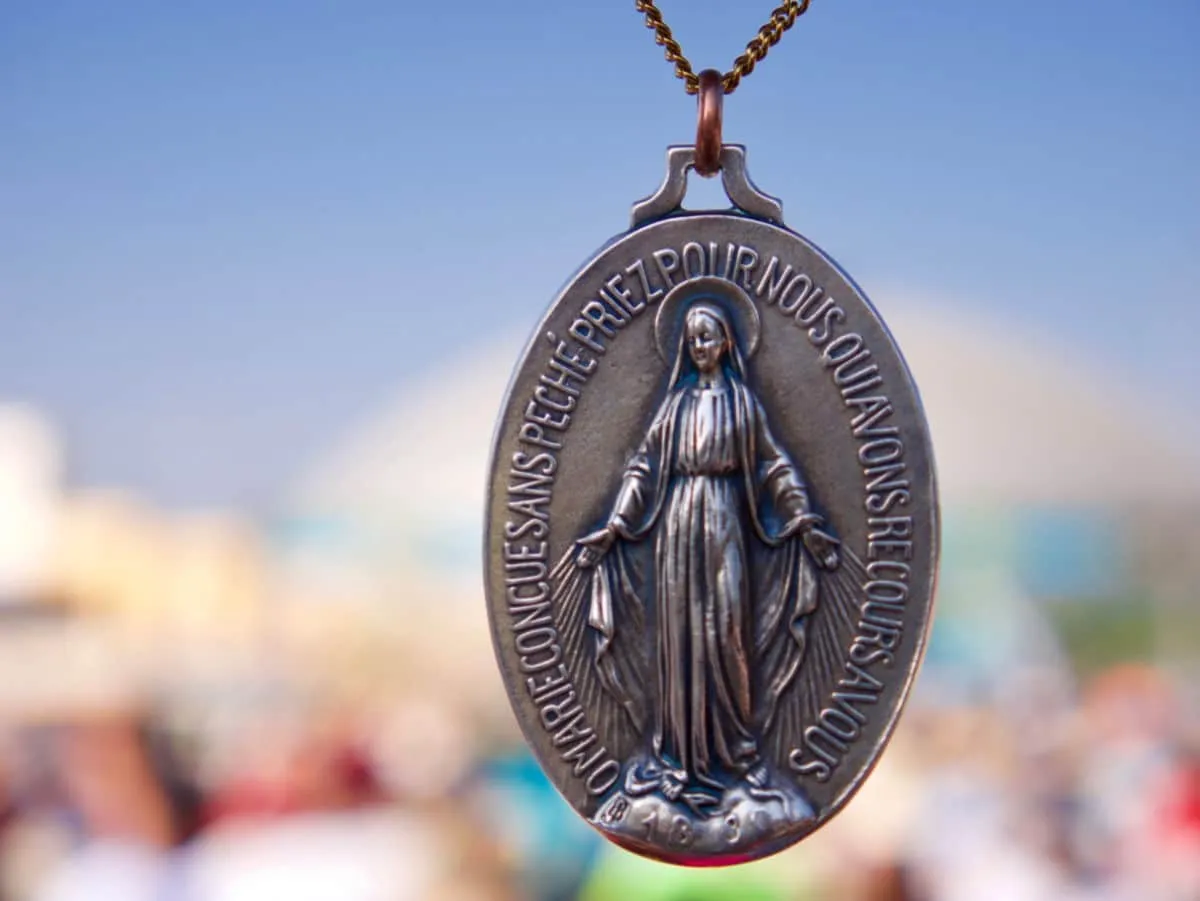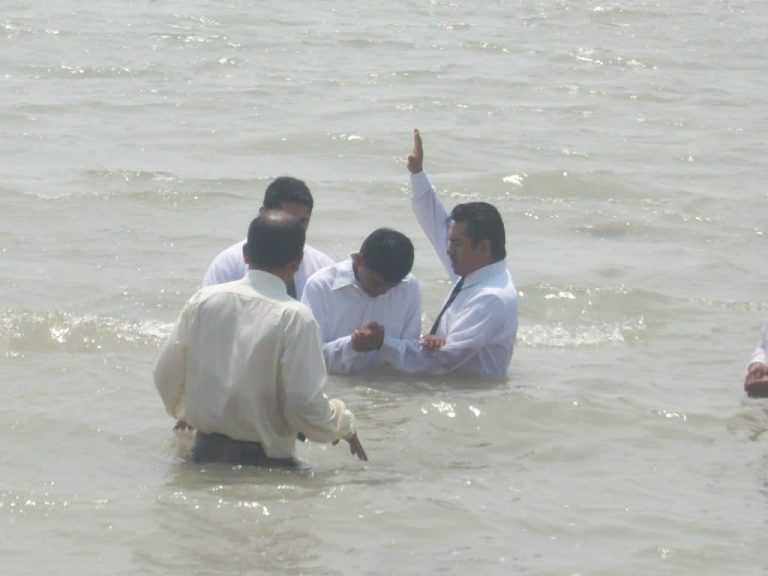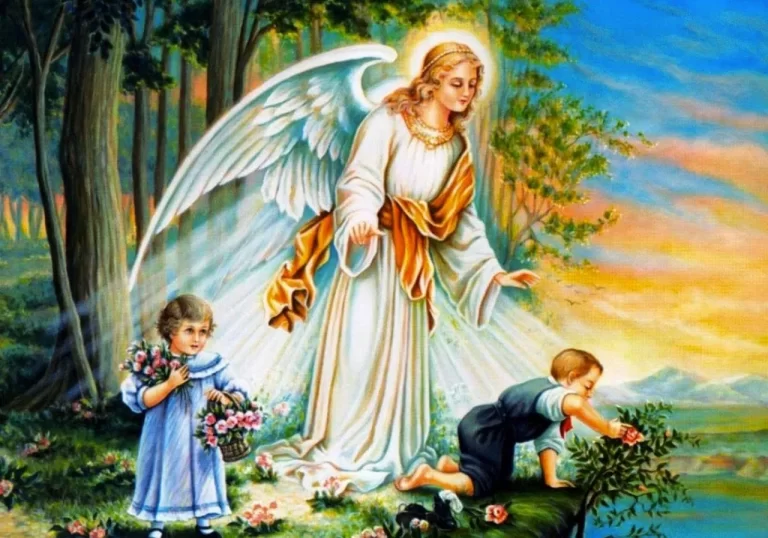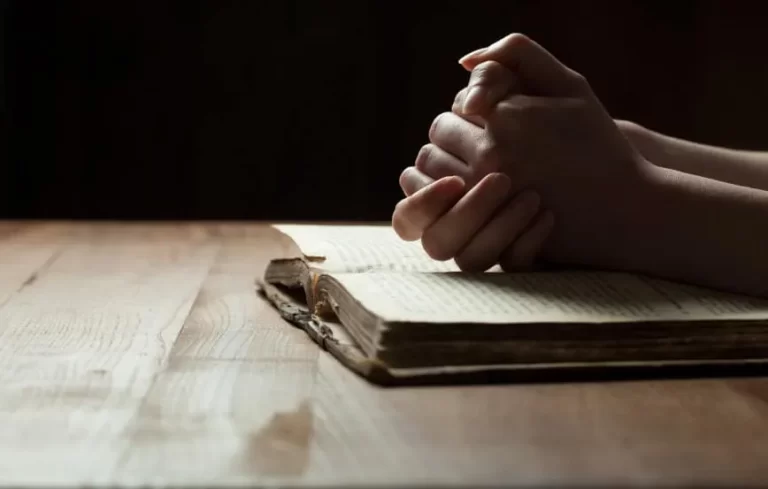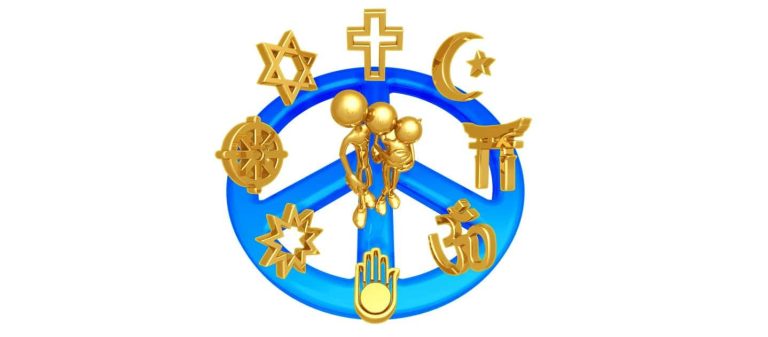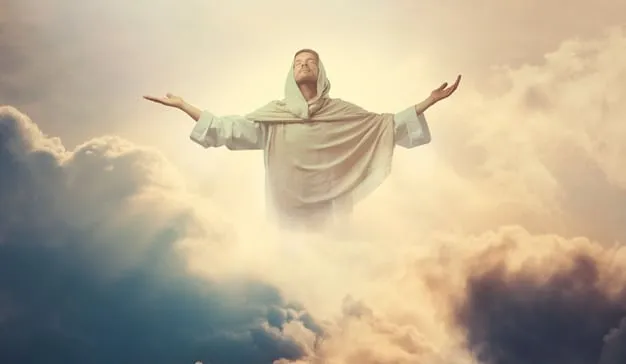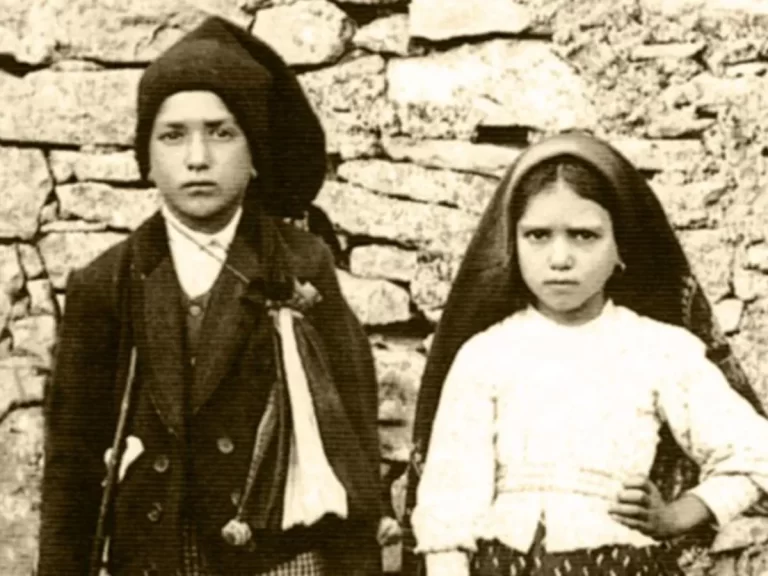Our Lady of the Miraculous Medal: What is it?
The Immaculate Conception Medal, which is better known as the Miraculous Medal , received its design on instructions from the Blessed Virgin herself. For this reason, it is not surprising that it grants such great favors to those who carry it and pray for the mediation and help of Mary. By wearing this medal you are spreading this extraordinary devotion just as you do by sharing this article.
Our Lady of the Miraculous Medal
The Miraculous Medal is one of the sacred symbols that have been established by the Church. It is a physical symbolization of a spiritual substantivity. Since its introduction, the Virgin of the Miraculous Medal has been recognized as a powerful source for attracting divine graces to humanity, even in the form of miracles.
What is the Miraculous Medal?
The Miraculous Medal is a sacramental, an instrument to prepare our souls for the reception of divine grace. A sacramental affects you primarily in two ways: it cleanses venial sins by preparing the heart to perceive sorrow for sins, and it helps to overcome temptations.
A sacramental is not a good fortune charm or some kind of free pass to heaven. It is, rather, a link between heaven and earth, a physical expression of the spiritual substantivity of the love that God grants us and of the intermediation of his Blessed Mother.
Just like a reliquary that bears a photo of our mother, the Miraculous Medal reminds us of the Virgin Mary, and helps us summon her and converse with her when we find ourselves in trouble. God wants us to use sacramentals to keep spiritual realities in mind, and He bestows His favor in a special way on those who use them in this way.
Mary’s Message to Catherine
The Virgin Mary notified Sister Catherine Labouré of the following in 1830: “Have a medal struck according to this model. Those who wear it will obtain great favors, particularly if they wear it around the neck.” Catherine confessed to her priest in detail each of the various visions she had had with the Virgin. She did not make public that she had obtained the design for the Medal until some time before her death, 47 years later.
With the consent of the Church of the Miraculous Medal , the initial medals were made in 1832 and distributed in Paris. Almost immediately, the blessings that Mary had secured began to pour out on those who wore her medal. Devotion spread like fire. Miracles of favors, health, harmony and prosperity arose. Before long, people began calling it “the Miraculous Medal.”
In 1836 a canonical inquiry was launched in Paris proclaiming the apparitions as genuine. There is no superstition or magic when it comes to the Miraculous Medal. The Miraculous Medal is not considered “an element to achieve good fortune”, but rather, it is a great manifestation of faith and confidence in the power of prayer.
His most important miracles are those of serenity, absolution, repentance and hope. God uses a medal, more than as a sacrament, as a means, an instrument to attract wonderful favors. “The easy things of this earth God has chosen to disorient the strong.”
When the Blessed Virgin gave the design of the medal to Sister Catalina Labouré, I pointed out to her: “Now you must give it to each and every one of the people”. The Miraculous Medal Association in Perryville, Missouri practices Our Lady’s request in many ways, including providing you with a free Miraculous Medal.
Apparitions of the Virgin Mary to Saint Catherine Labouré and the Miraculous Medal. Paris, 1830
The year 1830 was one of the most important years, since it is in Paris where the Blessed Virgin appears for the first time in modern times. What Pius XII called the “era of Mary” begins, a phase of repeated divine visitations. Among them stand out: La Salette, Lourdes, Fátima…
And as in his presence in Saint Elizabeth, he usually comes to bring us grace, to bring us closer to Jesus, the blessed fruit of her womb. Also to remind us of the path of redemption and warn us of the consequences of seeking other paths.
Saint Catherine Labouré
In the French town of Fain-les-Moutiers, Burgundy, Catherine Labouré was born on May 2, 1806. She began her religious activity with the Daughters of Charity on January 22, 1830 and three months after applying, she was transferred to the novitiate in Paris, in the Rue du Bac on April 21. The Miraculous Medal Parish is officially established in this town .
The Heart of Saint Vincent
The beginner was present at the time of the transfer of the remains of the founder of this institution, San Vicente de Paul, to the most recent church of the Paules Fathers just a few blocks away. The apostle’s right arm was destined for the novitiate chapel.
In this tabernacle, through the novena, Catalina was able to contemplate the heart of Saint Vincent in various colors. White, meaning the alliance that should exist between the congregations created by Saint Vincent. Red, meaning the devotion and diffusion that such congregations should have. Dark red in color, to signify the affliction of the pain that she would suffer.
He heard a voice inside him: “The heart of Saint Vincent is extremely saddened by the calamities that are approaching France.” With the same voice, something was added later: «The heart of Saint Vincent is more comforted by having received from God, through the mediation of the Blessed Virgin Mary, the message that both congregations will not succumb in the midst of these misfortunes, but rather the Lord will use them to revive faith.”
Visions of the Lord in the Eucharist
In the 9 months of her formation at Rue du Bac, Sister Catherine also had the special favor of contemplating the Lord in the Blessed Sacrament every day.
That Holy Trinity Sunday, June 6, 1830, God made his appearance as a King through the gospel of the office, with a crucifix on his chest. Suddenly, the royal ornamentation of Jesus fell to the floor, as did the cross, like disposable debris. «Immediately, according to what was written by Sister Catalina, I conceived the darkest and most terrible ideas: that the King of the earth was lost and his royal robes would be taken from them. True, bad things were coming.
Catherine Dreams of Seeing the Virgin
On Sunday, July 18, 1930, the day before the celebration of Saint Vincent de Paul, the instructor of novices had told them about the devotion to the saints, and especially to the Queen of them all, Mary Most Holy. Her expressions, full of faith and ardent compassion, awakened in Sister Labouré’s heart the desire to see and appreciate the face of the Blessed Virgin. As it was the eve of Saint Vincent, they had given each of them pieces of cloth from a saint’s vestment.
Catalina thought so and went to bed with the idea that Saint Vincent, together with his guardian angel, would give her that same night the favor of contemplating the Virgin as she longed for. Precisely, the previous favors obtained in the various apparitions of Saint Vincent to Sister Catalina gave him an unlimited certainty towards her venerable father, and her candidness and lively illusion did not lie to him. “Trust achieves everything that it knows how to wait for” (San Juan de la Cruz)
The Angel wakes her up
Everything was still in the room where Sister Catalina was dozing and as 11:30 pm approached she heard her name called on three occasions. He woke up and slightly opening the curtains of his bed, he looked to the side where the voice came from and then observed a boy dressed in white, apparently about four or five years old, and who pointed out to him: «Get up quickly and go. to the chapel; the Blessed Virgin awaits you.”
Sister Catalina is doubtful since she is afraid that the other novices will find out; but the child responds to her inner restlessness and tells her: «Don’t be afraid; at 11:30 p.m.; they are all well asleep. Come, I’ll wait for you.” She begins to get ready quickly, dressing quickly and putting herself at the command of her enigmatic guide, “that she stood without departing from the column of her bed.”
Already dressed Sister Catalina, the boy begins to walk, and she escorts him on “his left side.” Wherever they passed, the lights began to come on. The child’s body gave off bright lights and everything lit up as he passed. Arriving at the door of the chapel he gets it closed; but it opens the moment the child touches it with his little finger.
Catalina comments: «My astonishment was greater when, upon entering the chapel, I saw all the candles and candles lit, which reminded me of the midnight Mass.» (even she has not seen the Virgin). The boy leads her to the presbytery, right next to the Fr. Director’s chair, in which he used to preach to the Daughters of Charity, and there he knelt down, and the boy remained standing all that time on the right side.
It seemed to him that he had waited a long time since he longed to see the Virgin. She gazed uneasily towards the dais to her right, in case her fellow vigiles, who usually stopped to perform an act of worship, might see her. At last the long-awaited hour arrived, and the boy pointed out to him: «Go here to the Virgin, observe her here.»
Sister Catalina heard a noise, like the rustling of a silk dress, coming from the side of the dais, near the portrait of Saint Joseph. She could see that a lady of great beauty, majestically crossed the sanctuary, “and went to sit in an armchair above the steps of the upper altar, on the Gospel side.”
Sor Catalina in the depths of her heart doubted whether or not she was really in the presence of the Queen of Heaven, but the child pointed out to her: “Look at the Virgin.” It was almost impossible to review what she was experiencing at that time, what was happening inside her, and apparently she could not see the Blessed Virgin.
It was when the boy spoke to him, not with a childish voice, but as a man with more energy and very sonorous words: – «Can not the Queen of Heaven manifest herself to a humble mortal creature in the way she pleases? ?»
Then, contemplating the Virgin, I placed myself in a moment at her side, I knelt in the presbytery, with my hands placed on the knees of the Blessed Virgin. «The most pleasant moments of my life occurred there; There are no words that can express what I felt.”
She told me how I should behave towards my director, how to conduct myself in my sorrows and attend (pointing to me with her left hand) to lie down at the foot of the altar and calm my heart there, because there I would obtain all the consolations that I needed. So I asked her what the things I had observed meant, and she cleared everything up for me.”
Instructions of the Blessed Virgin
Numerous were the revelations that Sister Catalina obtained from the lips of the Most Holy Mary, but we will never be able to know all of them, since in relation to some of them, the most complete secrecy was implanted in her. Even so, the Virgin granted her some recommendations for her particular spiritual benefit: (The Virgin is Mother and Tutor).
1.- How should be his behavior with his director (profound modesty and submission). This despite the fact that his cleric, Father Juan María Aladel, was not credulous of his visions and told him to ignore them.
2.- The way of behaving in sorrows, (serenity, docility, pleasure)
3.- Always attend (indicating him with his left hand) to lie down at the foot of the altar and calm his heart, because there he would obtain all the consolations he needed. (indivisible heart, not human reliefs)
The Virgin also clarified the significance of all the visions and manifestations that she had experienced with Saint Vincent and the Lord. She then continued pointing at him:
«God has to trust you with a mission; It will be hard for you, but you will achieve it knowing that you do it for the glory of the Lord. You will know how gracious God is. You will have to suffer until you let your director know.
“Inconsistencies will assail you; more you will get favors; do not be afraid. Tell your director with faith and simplicity; he trusts and fear not. You will observe certain things; tell them. You will get inspiration in prayer.”
«The times are very fateful, since misfortunes will fall on France. The throne will be deposed and the entire world will be overwhelmed by disasters of all kinds (when pointing out this the Virgin was very afflicted). Come to the foot of this altar, in which graces will be granted to those who pray for them fervently; everyone, big and small, rich and poor.
“I long to spread favors to your community; I wish it fervently. It pains me that there are enormous excesses in obedience, that the rules are not followed, that there is so much distension in the two communities despite the fact that there are great souls in them. Tell it to the one who takes care of you, even though he is not the superior ».
“In a short time he will be placed at the head of the community. He will have to do everything he can to restore the force of the rule. When this happens, another community will join yours.”
“The time will come when the danger will be enormous; all will be considered lost; at that moment I will be by your side, trust. You will notice my visit and the divine protection and Saint Vincent over both communities».
«It will not be the same in other communities, in them there will be victims (tears in the eyes.) The church of Paris will have numerous victims. The Archbishop will perish.
«My daughter, the cross will be vilified, and the Heart of my Son will be pierced again; blood will be shed in the streets (the Virgin could not speak of her sorrow, the words did not come from her throat; pale face.) The whole world will be in anguish. She meditates: when will this happen? and an inner voice affirms: forty years and ten and then peace».
The Virgin, after spending a couple of hours with her, vanishes from Sister Catalina’s sight like a shadow that fades. In this vision of the Virgin, this one:
- He is involved in a mission that God wishes to entrust to him.
- He enlists you with wise advice to communicate with humility and faith to your manager.
- It warns you of upcoming events to strengthen the faith of those who might doubt the vision.
- She gives her a family bond of mother-daughter: she observes her, approaches her, they talk with familiarity and simplicity, she touches her and the Virgin not only agrees, but when she sits down she makes it possible for Catalina to come closer to the point of even resting her arms and hands on the knees of the Sovereign of Heaven.
All of his prophecies were fulfilled:
1.- God’s mission was soon pointed out to him with the discovery of the miraculous medal.
2.- After a week of this vision, the revolution began. The rebels took to the streets of Paris, looting, killing and finally Charles X was deposed, replaced by the “citizen monarch” Louis Philippe I, great mentor of Freemasonry.
3.- Fr. Aladel (director) is appointed Director of the Daughters of Charity in 1846, establishes the obedience of the rule and in the 1960s another female community joins the Daughters of Charity.
4.- By 1870 (at the age of 40) the time of great danger arrived, with the barbarities of the Commune and the execution of Archbishop Monsignor Darboy and numerous other priests.
5.- Just the last episode remains to be done.
Apparition of November 27, 1830
At sunset on November 27, 1830, Saturday ( the day of the Miraculous Medal ), the day before the first Sunday of Advent, in the chapel, Sister Catalina was doing her meditation, when apparently she heard the rubbing of a silk dress that it reminded him of the last appearance.
The Blessed Virgin is shown, dressed in white with long sleeves and a tunic covered up to the neck. Her head was covered with a white veil that, without hiding her figure, descended on both sides to her feet. Wanting to describe her face, he barely got it right when she said that she was the Virgin Mary at her most beautiful.
Their feet rested on top of a white balloon, the top of which could barely be seen, and they crushed a green snake with yellow spots. His hands raised to the level of his heart supported another small gold globe, which was crowned by a little cross.
The Blessed Virgin kept an imploring attitude, as if offering the balloon. She sometimes she saw the sky and sometimes the earth. Suddenly her fingers were filled with rings ornamented with precious gems that shone and poured her light from her to all sides of her, surrounding her at this moment with such luminosity, that it was impossible to observe her.
He had three rings on each finger; the thickest next to the hand; a medium-sized one in the center, and a smaller one at the end. Rays emerged from the precious gems of the rings, extending downwards; They filled the entire lower part.
As Sister Catherine saw the Virgin, she observed her and spoke to her heart: This globe that you contemplate (at the feet of the Saint) symbolizes the whole world, particularly France, and each individual soul. These rays represent the favors that I spread on those who implore them. The pearls that do not emanate rays are the favors of the souls that do not pray.
With these offerings, the Virgin is understood as the intermediary of the favors coming from Jesus Christ. The golden globe (the abundance of favors) vanished from the Virgin’s hands. Her arms spread open, as the rays of light continued to descend on the white globe of her feet.
The Miraculous Medal
At that moment, an oval figure appeared around the Virgin and on the inside was written the following call: “Mary without sin you are conceived, implore us, who have come to you.” These words formed a semicircle that began at the level of her right hand, ascended above the head of the Holy Virgin, ending at the level of her left hand.
He heard his inner voice again: “Have a medal engraved according to this pattern. Those who carry it will obtain great favors. The favors will be more copious for those who carry it with faith.» The vision, then, took a half turn and what would be the reverse of the medal was formed in the same place.
On said reverse an M was shown, above which there was a cross resting on a bar, which crossed the letter up to a third of its height, and below the hearts of Jesus and Mary, of which the first was surrounded by a crown of thorns, and the second pierced by a sword. Around him were a dozen stars.
The same vision occurred again, under the same conditions, towards the end of December 1830 and the beginning of January 1831. The Virgin pointed to Catalina: «From this moment on, you will no longer be able to see, my daughter; but you will hear my voice in prayer.” One day that Sister Catalina was distressed because she did not know what inscription to place on the back of the medal, through prayer, the Virgin told her: “The M and the two hearts are extremely moving.”
Symbols of the Medal and Spiritual Message
Below is the design of the Miraculous Medal according to the precise indications that the Virgin Mary instructed Sister Catalina Labouré.
On the Obverse:
– María tamping the head of the snake that is on top of the world. She, the Immaculate, has the power by virtue of her favor to defeat Satan.
– The color of her clothing and the dozen stars above her head: the woman of the Apocalypse, dressed in the sun.
– Her expanded hands, communicated rays of grace, a symbol of her purpose as a mother and intermediary of the favors that she spreads over the world and to those who implore them.
– Jaculatory: doctrine of the Immaculate Conception (prior to the dogmatic definition of 1854). Mission of mediation, trust and petition to the Mother.
– The globe under her feet: Sovereign of heaven and earth.
– The globe in his hands: the world offered to Jesus by his hands.
In the reverse:
– The Cross: the enigma of salvation, the price paid by Christ. submission, martyrdom and delivery.
– The M: sign of Mary and her spiritual pregnancy.
– The bar: it is a symbol of the Greek alphabet “yota” or I, which is the initial of the name, Jesus.
Gathered them: The Mother of Jesus Christ on the Cross, the Redeemer.
– The dozen stars: sign of the Church that Christ creates over the apostles and that emerges on Calvary from his pierced heart.
– The pair of hearts: the co-redemption. inseparable unit. Future veneration to the two and their reign.
Name:
The Medal was originally called: “of the Immaculate Conception” but as devotion spread and there were numerous miracles granted through it, it was popularly named “The Miraculous Medal.”Saint Catherine Labouré
Coming into the world on May 2, 1806 in the French town of Fain-les-Moutiers, in Burgundy. Her family worked in the fields and she lost her mother at the age of 9, when she was entrusted to the Blessed Virgin to serve as her mother, and the Mother of God accepted her request. When her older sister left as a Vincentian nun, Catalina was left in charge of the kitchen and laundry tasks in her father’s house, so she did not learn to read and write.
When she reached the age of 14, she asked her father to authorize her to go to a convent as a novice, but he, who required her to attend to numerous household chores, did not give her permission. She implored Our Lord to give her what she longed for so much: to be a religious.
And one night he dreamed of an old priest telling him: “One day you will support me in caring for the sick.” The figure of that religious kept her forever in her memory.
It was when she was 24 years old, when she was able to get her father to let her go visit her religious sister, and when she arrived at the monastery room she saw the painting of Saint Vincent de Paul there and realized that this was the old religious from his dreams, the one who had invited him to help him with the care of the sick. From that date on, she considered being a Vincentian sister, and she persisted so much that she was finally received into the community.
On November 27, 1830, while Saint Catherine was praying in the chapel of the monastery, the Virgin Mary showed herself completely resplendent, spreading beautiful rays of light towards the earth from her hands.
She commissioned him to make an image of Our Lady just as it had been shown to her and to have a medal struck with the initials of the Virgin Mary “M” on one side, and a crucifix, with this prayer “O Mary, sinless you were conceived, implore for us who come to you». And she made promises of very special graces for those who wear this medal and pray that prayer.
Catalina reported this apparition to her priest, but he did not take it into account. However, the priest, realizing Catherine’s sanctity, mediated with the Archbishop to obtain permission to make the medals and therefore the miracles.
From 1830, the date of the visions, until 1876, the date of her death, Catherine remained in the monastery without anyone knowing that she was the one to whom the Virgin Mary had been shown to entrust the Miraculous Medal. In recent years she managed to have an image of the Miraculous Virgin placed in the place where she had made her appearance.
Finally, eight months after her death, her former priest dead, Catherine told her new superior about all the visions in detail and it became known who was the blessed one who had contemplated and listened to the Virgin. That’s why when she died, the whole town was present at her funeral. It was not until 1947 that the holy Father Pius XII proclaimed Catalina Labouré Saint.
Ratisbone Conversion
Alfonso Ratisbone was a jurist and banker, Jewish, who was 27 years old. He expressed the enormous aversion to Catholics since his brother Teodoro converted and ordained as a priest, and wore the miraculous medal as a badge and fought for the conversion of the Jews.
Alfonso considered marrying a daughter of his older brother, named Flora, a decade younger than him, when in January 1842, on a trip to Naples and Malta, due to a train error, he arrived in Rome. There he felt compelled to visit a family friend, Baron Teodoro de Bussiere, a Protestant turned Catholic.
The Baron greeted him cordially and offered to show him around the city. In a meeting in which Ratisbone expressed barbarities of the Catholics, this baron listened to him with great patience and finally said: «Since you are so confident of yourself, make me the promise to carry with you what I am going to give you – What will it be? This medal.
Afonso repudiated her indignantly, and the baron replied: ‘According to your ideas, admitting her should leave you apathetic. In contrast to me it would cause me complacency.” He started to laugh and put it on pointing out that he wasn’t stubborn and that it was a fun moment. The Baron placed it around his neck and made him pray the Memorare.
The baron asked for prayers from various people, including Count La Ferronays, who told him: “if he has placed the miraculous medal on him and made him pray for the Memorare, surely he will convert.” The earl passed away suddenly a couple of days later. It became known that in those two days he had gone to the Basilica of Santa Maria Maggiore to implore one hundred Memorares so that Ratisbone converted.
The baron was with Ratisbone on his last day in Rome in the surroundings of the Plaza España, and he invited him for a walk. But he previously had to attend the Church of San Andrés to prepare for the count’s funeral. Ratisbone keeps the Church company. Here is his statement of what happened on that date: «A few moments after arriving at the Church, I felt subjected to an incomprehensible embarrassment. I looked up and it looked like the entire building was fading from my sight.
One of the tabernacles (that of Saint Michael) had attracted all the light, and in the center of that brilliance made her appearance on the altar, resplendent and full of majesty and sweetness, the Blessed Virgin as she appears engraved on the medal . A force that I could not resist carried me towards the tabernacle. It was like this when the Virgin made a gesture with her hand as if asking me to get on my knees… The Virgin did not say anything but I understood everything. »
The baron gets it on his knees, sobbing and imploring with joined hands and kissing the medal. Some time later he is baptized in the Church of the Gesu in Rome. By mandate of the Pope, a canonical process begins, and it was proclaimed “authentic miracle.” Alfonso Ratisbone entered the Society of Jesus. He was ordained a priest and assigned to Paris where he was collaborating with his brother Theodore in the catechumenates to convert the Jews.
After having been part of the Jesuits for a decade, with authorization he left the order and created in 1848, the nuns and the missions of Our Lady of Sion. In just the first ten years Ratisbone achieved the conversion of 200 Jews and 32 Protestants.
He worked diligently in the Holy Land, managing to acquire the old Praetorium of Pilate, which he transformed into a convent and Church for the nuns. He also managed to get these nuns to create a hospice in Ain-Karim, the place of his holy death in 1884 when he was 70 years old.

Hello! Let me enthusiastically introduce myself as a dedicated blogger fueled by an intense passion for meticulously crafting insightful and well-researched blogs. My mission revolves around providing you, dear readers, with a veritable treasure trove of invaluable information.

